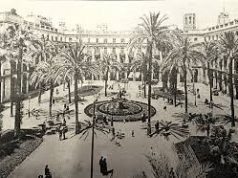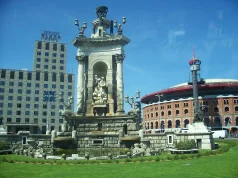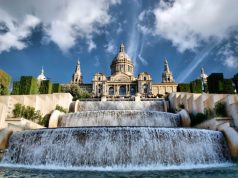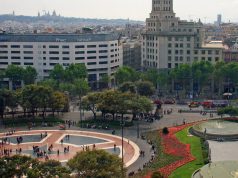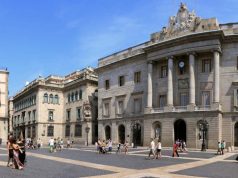A detailed look at some of the most famous streets and squares that are worth visiting in Barcelona. We also ask the question, which is the most famous street in Barcelona?
La Rambla, often referred to as Las Ramblas is commonly known as the most famous street in Barcelona. It runs from Plaza Cataluna to the port area, with a distance of around 1.2 km. La Rambla street is in between the Gothic Quarter and El Raval district. It has some famous attractions, such as the Liceu theatre, Mercat de la Boqueria and the Christopher Columbus monument. Covered with trees, cafés, and performances by street artists, it remains a firm favourite with people visiting Barcelona.
Origins and Evolution of La Rambla
The name La Rambla derives from an old Arabic word, “ramla,” meaning sandy riverbed. In its early days, this magnificent boulevard was nothing more than a humble dried-out stream outside the walls of the Gothic Quarter. However, as the 18th century unfolded, the first houses were constructed, gradually transforming the sandy riverbed into something resembling its present form—a sweeping, tree-lined boulevard at the heart of Barcelona.
La Rambla Attractions and Places to Visit
As you step onto La Rambla, you’ll find yourself immersed in a sensory feast. Here are some highlights along this 1.2 km stretch:
- The Canaletes Fountain: An elegant, late 19th-century, four-tapped drinking font adorned with the crest of the city of Barcelona. It’s not just a fountain; it’s where Barça fans gather to celebrate epic victories, title wins, and triumphs over Real Madrid in the el clásico Spanish derby. The Canaletes Fountain is more than water—it’s a symbol of passion and pride.
- Palace of the Virreina: A historic building that graces La Rambla, the Palace of the Virreina stands as a testament to the city’s architectural heritage. Once the residence of the Viceroy’s wife, it now hosts cultural exhibitions and events.
- Liceu Theater (Teatre Liceo): This grand theater has witnessed countless operas, ballets, and dramatic performances. Its ornate façade adds to the street’s allure, inviting both seasoned theater enthusiasts and curious passersby.
- Mercat de la Boqueria (La Boqueria Market): A bustling food market that opens off La Rambla, it’s a sensory explosion of colors, flavors, and aromas. Explore diverse stalls offering fresh produce, seafood, spices, and local delicacies. The market’s vibrant atmosphere reflects the essence of Barcelona’s culinary scene.
- Street artists: La Rambla is also home to street artists, such as acrobats, human statues and artists. In my opinion, these just add great value and a bit of fun to an already vibrant street.
The Vibe of the Most Famous Street in Barcelona
La Rambla is a microcosm of Barcelona’s soul. As you stroll, you’ll encounter street performers, flower stalls, and outdoor cafes. The Parisienne vibe, created by colonnades of slender trees, invites you to linger and soak in the atmosphere. Yet, it’s also a place of contrasts, where the historic Gothic Quarter meets the shabby chic area of El Raval. Here, the past intertwines with the present, and every step reveals layers of stories waiting to be discovered.
Eating, Drinking, and Staying
- Bars and Restaurants: The boulevard boasts an array of dining options. Sip sangria at a sidewalk café, savor tapas, or indulge in seafood paella. Whether you’re a foodie or a casual diner, La Rambla caters to all tastes.
- Hotels and Rooms: If you seek accommodation in the heart of the city, consider staying near La Rambla. It’s a vibrant base for exploring Barcelona. From boutique hotels to charming guesthouses, you’ll find a range of options to suit your preferences. Hotels and hostals are situated on La Rambla itself, or in nearby side streets.
Walking Tours and Beyond
- Walking Down La Rambla: A rite of passage for first-time visitors, this leisurely stroll offers glimpses of Barcelona’s past and present. Pause at the mosaic by Joan Miró, admire the human statues, and soak in the energy of the street.
- Beyond La Rambla: Venture into nearby neighborhoods. Explore the Gothic Quarter’s narrow alleys, discover hidden squares, and marvel at medieval architecture. Or head to El Raval, known for its street art, trendy boutiques, and multicultural vibe.
Is Barcelona’s Most Famous Street Worth a Visit?
For those seeking the most famous street in Barcelona, La Rambla is an essential destination. Its rich history, vibrant culture, and central location make it a must-visit for travelers. Whether you’re drawn to its lively energy, architectural gems, or culinary delights, Las Ramblas Barcelona promises an unforgettable experience.
In summary, La Rambla weaves together history, culture, and modern life. Whether you’re a curious traveler, a passionate food lover, or an architecture enthusiast, this iconic street invites you to experience it’s unique urban vibe.

Passeig de Gràcia: Another Famous Street in Barcelona
Passeig de Gràcia, located in the heart of Barcelona’s Eixample district, is much more than just a street. It’s a vibrant boulevard that seamlessly blends history, culture, and luxury. Let’s explore why Passeig de Gràcia is a must-visit destination for anyone exploring the Catalan capital.
Originally known as Camí de Jesús (“Jesus Road”), Passeig de Gràcia was once a rural lane connecting Barcelona and the town of Gràcia. Over time, it transformed into a grand avenue, attracting aristocrats eager to showcase their horse riding skills and elegant horse-drawn carriages. In the 19th century, it became the city’s most fashionable street.
Architectural Marvels of Barcelona
Passeig de Gràcia boasts an impressive collection of architectural gems, designed by renowned modernista (Art Nouveau) architects. Here are some notable buildings you’ll encounter:
- Casa Batlló by Antoni Gaudí: This whimsical masterpiece, resembling a dragon, features a colorful façade adorned with intricate ceramic tiles and wrought-iron balconies.
- Casa Milà (La Pedrera), also by Gaudí: Its undulating stone facade and wrought-iron balconies make it a true marvel. Don’t miss the rooftop with its surreal chimneys.
- Casa Lleó Morera by Lluís Domènech i Montaner: An elegant building with floral motifs and stained glass windows, it’s a testament to Catalan modernism.
- Casa Amatller by Josep Puig i Cadafalch: Its ornate façade and bay windows are a sight to behold.
- Casa Fuster, where the Catalan poet Salvador Espriu once resided.
- Illa de la Discòrdia (Block of Discord): A stretch of Passeig de Gràcia featuring three remarkable buildings—Casa Batlló, Casa Amatller, and Casa Lleó Morera.
Shopping and Gastronomy on the Passeig de Gràcia
Passeig de Gràcia is synonymous with luxury shopping. International fashion brands, upscale boutiques, and designer stores line the avenue. Whether you’re looking for haute couture, fine jewelry, or stylish accessories, this street has it all. When hunger strikes, explore the gastronomic delights. Chic restaurants, trendy cafés, and tapas bars await. Savor Catalan cuisine, sip on local wines, and indulge in sweet treats.
Beyond Passeig de Gràcia
Don’t limit your exploration to the avenue itself. Nearby attractions include:
- Plaça Catalunya: The starting point of Passeig de Gràcia and La Rambla, this bustling square is a hub of activity.
- Casa Milà: Visit this UNESCO-listed building and learn about its fascinating history.
- Teatre Tívoli: Catch a show at this historic theater.
- Jardins de Salvador Espriu: A tranquil oasis to relax and enjoy nature.
Passeig de Gràcia is more than just a street—it’s a living canvas of architectural brilliance, a shopper’s paradise, and a cultural hotspot. So, put on your walking shoes and immerse yourself in the elegance and allure of this iconic Barcelona gem.
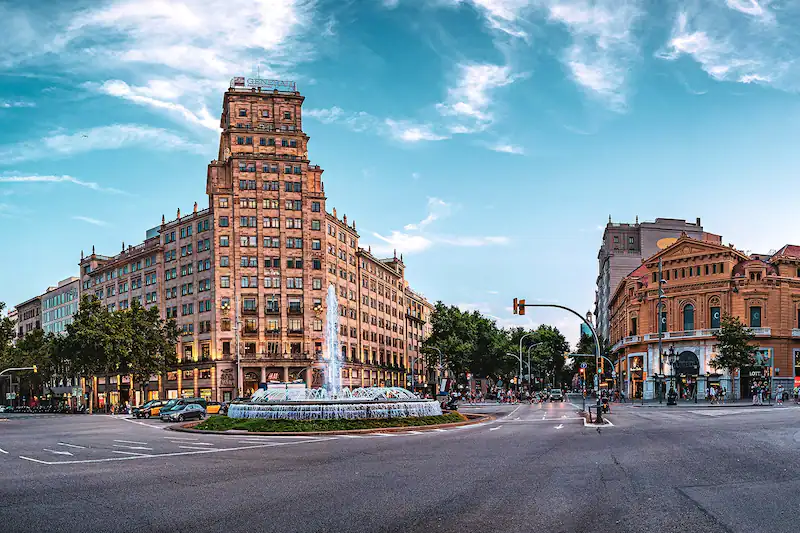
1. Passeig del Born
History:
- Passeig del Born, with its medieval allure, has witnessed significant events. Knights once settled disputes through duels here, and during the sixteenth century, it was the grim site of Inquisition executions.
- In 1714, during the Siege of Barcelona, Felipe V’s army seized this street.
- Today, Passeig del Born hosts Holy Week and carnival parades, filling the air with traditional songs and street food vendors.
Importance:
- This neighborhood is often described as “the most authentic and picturesque section of Barcelona.”
- It’s a hub for leisure, nightlife, and local experiences.
Nearby Attractions:
- Santa Maria del Mar: A stunning Gothic basilica nearby.
- Picasso Museum: Just a short walk away, housing an impressive collection of Picasso’s works.
- El Born Centre Cultural: A cultural center built atop medieval ruins, offering exhibitions and events.
2. Carrer Dels Mirallers
History:
- Carrer Dels Mirallers, also known as the Spooky Street, exudes mystery and intrigue.
- Its name translates to “Mirror Makers Street,” hinting at its past as a hub for artisans creating mirrors.
Importance:
- While lesser-known, this street is a hidden gem waiting to be explored.
- Its narrow lanes and historic buildings evoke a sense of timelessness.
Nearby Attractions:
- Basilica de Santa Maria del Pi: A Gothic church with a magnificent rose window.
- Plaça Sant Felip Neri: A serene square with a tragic history related to the Spanish Civil War.
3. Carrer de Montcada
History:
- Carrer de Montcada boasts a blend of Renaissance and Baroque architecture.
- Once home to wealthy merchants and nobility, it showcases their opulent residences.
Importance:
- This street is a living testament to Barcelona’s prosperous past.
- It houses several museums and art galleries.
Nearby Attractions:
- Museu Picasso: A must-visit for art enthusiasts, featuring Picasso’s early works.
- Palau Dalmases: An elegant palace hosting flamenco performances.
4. Carrer Dels Escudellers
History:
- Carrer Dels Escudellers, affectionately known as the Local’s Favorite Spot for Food Street, is a culinary haven.
- Its name refers to the artisans who crafted shields (escudellers) in medieval times.
Importance:
- This street embodies the spirit of local life, bustling with cafes, tapas bars, and eateries.
- It’s where you’ll find authentic Catalan flavors.
Nearby Attractions:
- Mercat de la Boqueria: A vibrant food market brimming with fresh produce and delicacies.
- Plaça Reial: A picturesque square with fountains, palm trees, and lively ambiance.
5. Carrer Del Bisbe
History:
- Carrer Del Bisbe, the Main Street of Medieval Barcelona, connects the Cathedral Square (Plaça de la Seu) with Plaça Sant Jaume.
- Its stunning Gothic archway, the Bridge of Sighs, links the Palau de la Generalitat with the Casa dels Canonges.
Importance:
- This street epitomizes the city’s rich heritage and architectural splendor.
- The Bridge of Sighs is a symbol of love and legend.
Nearby Attractions:
- Barcelona Cathedral: A masterpiece of Gothic architecture.
- Plaça Sant Jaume: The political heart of the city.
Barcelona’s lesser-known streets weave a tapestry of history, culture, and local life. As you explore these enchanting alleys, remember that beyond the grand boulevards lies a world of hidden treasures.
Most Famous Squares in Barcelona Worth Visiting
Let’s explore some of Barcelona’s captivating historic squares, each with its own unique charm, stories, and cultural significance. From the winding streets of the Gothic Quarter to bustling plazas, these squares are a testament to the city’s rich past. Here are a few notable ones:
The Plaça de Sant Felip Neri:
- Description: Arguably the prettiest square in Barcelona, Plaça de Sant Felip Neri is nestled in the Gothic Quarter. It takes its name from the small Baroque church that graces one side of the plaza.
- History: Built on the site of a medieval graveyard, this tranquil square witnessed tragic events during the Spanish Civil War. A bombing raid claimed the lives of 42 children and damaged the church façade and surrounding buildings.
- What to See and Do: Admire the octagonal stone fountain, shaded by tall trees. Explore the gothic buildings, including a small museum. Remember the poignant history as you stroll through this serene oasis.
The Historic Plaça Reial:
- Description: Possibly the liveliest plaza in Barcelona, Plaça Reial exudes elegance. Neoclassical apartment buildings line the square, once home to the city’s wealthier residents. Plaça Reial is located next to La Rambla.
- History: Constructed during the 19th century, it boasts an impressive fountain (El Font de les Tres Gràcies) and unique streetlamps designed by Antoni Gaudí.
- What to See and Do: By day, relax at al fresco bars and restaurants. At night, immerse yourself in the vibrant nightlife. Visit iconic venues like Sidecar, Jamboree, Los Tarantos, and Pipa Club.
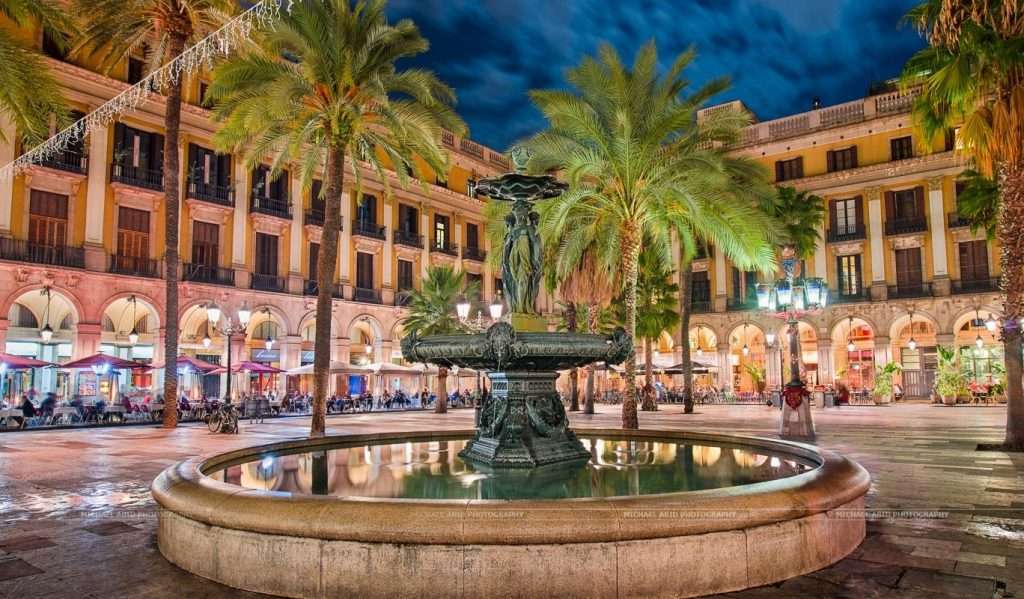
Charming Plaça Prim:
- Description: Located near the beach in the Poblenou neighborhood, Plaça Prim (also known as Plaça dels Pescadors) exudes coastal charm. Whitewashed fishermen’s houses surround the square.
- History: The cast-iron fountain provides water to passers-by seeking shade under three gnarly Ombu trees.
- What to See and Do: Enjoy the simplicity of this square, reminiscent of coastal villages. Take in the quaint architecture and soak up the relaxed atmosphere.
Plaça de la Sagrada Família:
- Description: This square lies in the shadow of the iconic Sagrada Família basilica.
- History: It serves as a gathering point for visitors exploring Gaudí’s masterpiece.
- What to See and Do: Admire the intricate details of the basilica, take photos, and perhaps enjoy a coffee at a nearby café.
Plaça de la Vila de Gràcia:
- Description: Located in the Gràcia neighborhood, this square is a hub of local life.
- History: Once a separate village, Gràcia retains its bohemian spirit. The square reflects this character.
- What to See and Do: Explore the charming streets leading off the square, visit local shops, and savor the neighborhood’s artistic vibe.
Remember, these squares are more than just physical spaces—they hold the echoes of Barcelona’s past and the vibrancy of its present. Each square is unique, with different styles of architecture dating from the time pf each square’s conception. A visit to one of Barcelona’s historic squares is also a time to enjoy a coffee in one of the nearby cafés. A chance to relax, admire the charm of the square and watch the habitants of Barcelona participate in their daily lives.



